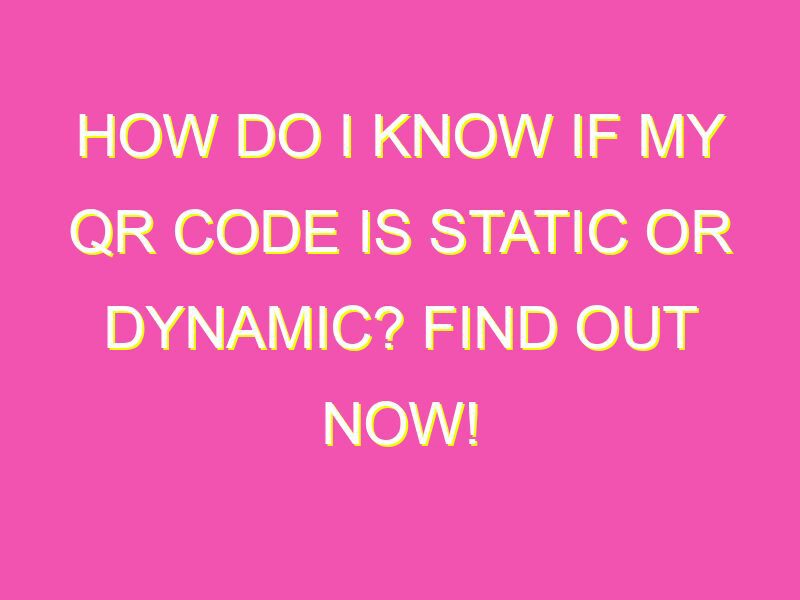Are you using QR codes for your business or personal use? Knowing the difference between static and dynamic QR codes is essential for creating the best experience for your customers. Static QR codes are limited in their ability to provide new and exciting content to customers as they lead to a hard-coded URL within the pattern of the code. On the other hand, dynamic QR codes open up a world of possibilities by leading to an editable URL that can be updated with new content at any time. Don’t let your QR code marketing strategy fall behind, make sure you are using dynamic QR codes to stay ahead of the game. Follow the simple steps outlined to ensure that you are using the right type of QR code for your needs.
Understanding QR codes: Static vs Dynamic
QR codes have become an essential marketing tool in the digital world. QR codes are commonly used to link physical objects or printed materials like billboards, business cards, posters or even websites to an online destination, making it easy and convenient for users to access information quickly. With the widespread use of QR codes, it is important to understand the difference between a static and dynamic QR code. In this article, we will clarify these concepts and explore how to identify, use and benefit from them.
What’s the difference between static and dynamic QR codes?
A static QR code is one where the destination URL is hardcoded or stored within the QR code’s pattern. That means the URL associated with a static QR code remains permanent throughout its lifecycle, so it cannot be changed or updated. In contrast, a dynamic QR code contains an editable URL for the final destination. Dynamic QR codes allow the URL destination to change even after the QR code has been printed, which provides more flexibility in managing marketing and promotional campaigns with multiple destinations.
How QR codes work
QR codes are created by software that takes the URL or other information entered by the user and converts it into a 2D image. The image consists of black and white squares arranged in a specific pattern that can be scanned by a smartphone’s camera. When the QR code is scanned, it decodes the pattern and sends the user to the associated online content. The content associated with the QR code must be mobile-optimized and accessible through a smartphone or mobile device.
Identifying a static QR code
One way to identify a static QR code is to check if the URL or the destination point is visible on the QR code itself. In static QR codes, this URL or destination is hardcoded, which means there is no way to change it once it is created. Thus, if the URL displayed on the website or other marketing material is the same as that present inside the QR code, it is more likely to be static rather than dynamic.
What is a dynamic QR code?
Dynamic QR codes are not limited to containing a single URL. Instead, dynamic QR codes can contain a variety of information types, including contact details, digital business cards, email addresses, telephone numbers, event details, and SMS messages, to name a few. The scannable information in a dynamic QR code can be easily updated, making it an ideal method for marketing campaigns that require frequent changes. A dynamic QR code can be conveniently managed in real-time, and its content changed as often as necessary.
How to tell if your QR code is dynamic
One simple way to determine if your QR code is dynamic is to scan it using a QR code reader that identifies whether the code is dynamic or static. Alternatively, you can try visiting the URL associated with the QR code. If the webpage displays different content after being scanned, then the QR code is dynamic. You can also compare the URL displayed in the content’s marketing material with that encoded in the QR code; if they differ, then the QR code is dynamic.
Benefits of using dynamic QR codes
Dynamic QR codes offer numerous benefits over static QR codes, especially for businesses who rely heavily on marketing campaigns. Here are a few key benefits of using dynamic QR codes:
- Flexibility: With dynamic QR codes, you can quickly and easily update your marketing campaigns with new content, offers or data. It saves time and effort compared to traditional advertising methods that require replacing existing materials.
- Customization: Dynamic QR codes can be customized with colors, logos, and other branding elements that align with your business, making them more identifiable and visually appealing.
- Trackable: Dynamic QR codes offer tracking and analytics features that allow you to monitor user behavior, gain insights into user engagement, and track campaign success through conversion rates and other metrics.
- Cost-effective: Dynamic QR codes are a cost-effective marketing tool, especially when compared to traditional marketing methods, such as print or broadcast media.
Dynamic QR codes: Uses and applications
Dynamic QR codes can be used in a variety of applications, including:
- Events: Use dynamic QR codes in conference badges, event posters or programs to provide attendees with instant access to event details, schedules, maps or session details.
- Product packaging: Embed dynamic QR codes on your product packaging, making it easy for consumers to find additional product information, promotions, or access product manuals.
- Retail: Use dynamic QR codes in-store to provide customers with instant access to special offers, coupons, and discounts.
- Business cards: Embed dynamic QR codes on your business card to provide instant access to your contact details, websites, and social media profiles.
In conclusion, whether you use dynamic or static QR codes depends on your marketing objectives and campaign requirements. While static QR codes are easy to create, dynamic QR codes offer more flexibility, customization, and tracking features. Dynamic QR codes enable businesses to change campaign strategies quickly to reflect market changes, stay ahead of competitors, and stay relevant to their customers.





